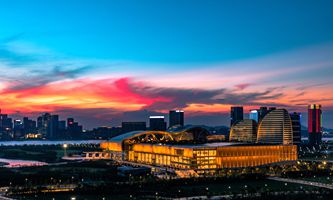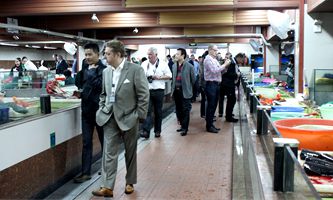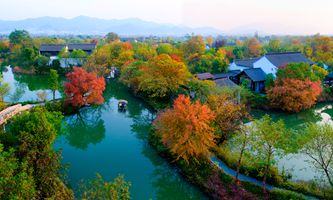Hangzhou National High-Tech Zone
Hangzhou National High-Tech Zone was among the first group of national high-tech development zones approved by the State Council.
In 2016, the zone maintained healthy and rapid development. It achieved GDP of 90.1 billion yuan ($14.08 billion), up 14.0 percent year-on-year. In the year, its fiscal revenue grew 17.7 percent to 23.5 billion yuan. The local fiscal revenue was 12.5 billion yuan, rising by 18.6 percent. Its high-tech industries had an increase of 13.4 percent and achieved revenue of 420 billion yuan, among them, the information industry was 225.3 billion yuan with an increase of 20 percent, accounting for 35 percent of the city’s total.
There are 230 enterprises with taxation exceeding 10 million yuan in the zone, 33 of them were in excess of 100 million yuan and five of them paid taxation of over 1 billion yuan each.
It topped the list in the comprehensive evaluation of Zhejiang province’s industrial counties (cities or districts), for the perspective of its index of industrialization and informatization integration. Moreover, it ranked first among 37 innovative pilot counties (cities or districts).
In Zhejiang’s first county economy top 30 rating, Hangzhou High-Tech Zone ranked top in terms of economic competitiveness, development potential and innovation. It only came after Beijing’s Zhongguancun Science Park and Zhangjiang Hi-Tech Park in Shanghai in the comprehensive assessment ranking of national hi-tech zones. It was listed in a national plan that aims to cultivate world-leading science parks by the Torch High Technology Industry Development Center, Ministry of Science and Technology, together with seven other science parks.
In the first three quarters of 2017, the zone achieved GDP of 80.8 billion yuan, rose by 13.5 percent. In the same period, its fiscal revenue was 24.8 billion yuan, up 27.9 percent, while its local general budget revenue had a growth of 24.5 percent to 12.2 billion yuan. By September 2017, the added value of the zone’s industries above designated size grew by 17.8 percent, and the growth of the hi-tech industries was 22.2 percent and the strategic emerging industries’ was 26.3 percent. The zone’s number of newly registered enterprises in the period was 5,867.
At present, the hi-tech industries account for 92 percent of the zone’s total added value of industries above designated size, 80 percent of the zone’s GDP, 80 percent of the industrial profits, as well as 93 percent of the zone’s total industrial exports.
The zone has built a complete internet information and technology industry chain, with focuses on independence innovation, cybersecurity and intelligent manufacturing in China. It has developed 100-billion-yuan scale smart economy industry and is capable of joining global competitions on behalf of China.
A group of leading players in their own industries, such as Alibaba, H3C and HIK Vision, were emerging in the zone, where many industrial clusters focuses on Internet Plus industries like e-commerce, intelligent health-care and intelligent environment protection.
Moreover, the overall level of e-commerce, digital video monitoring, broadband access equipment, integrated circuit design industry, software industry, animation production in the zone is also leading in the country.
To date, the zone has 40 listed companies. In recent years, the zone has been actively cultivating the blueprint of bio-medicine greater health industry and new energy environmental protection, and has achieved initial success. In 2016, the industrial revenue of bio-medicine greater health industry was over 20 billion yuan, while the new energy industry had revenue of 26.5 billion yuan.
In recent years, the zone’s R & D keeps accounting for as high as over 13 percent of its GDP. The growth of expenditure on scientific and technological activities generally keeps at around 20 percent. In 2016, the expenditures on research and development was 12.2 billion yuan, accounting for 10 percent of the province’s total. The zone’s patent applications number hit 140,000, and the invention patent applications exceeded 5,000. There are 236 invention patents per 10,000 people, while the figure in the country is 8.0, 16.5 in Zhejiang and 41.07 in Hangzhou.
The zone adheres to a virtuous investment promotion and talents introduction path, which enables the talents leading projects and attracts talents through projects.
It has implemented two rounds of 5050 Plan, cultivated and introduced 80 experts from the Recruitment Program of Global Experts (1000 Talents Plan at national level) and 10 experts from the Ten Thousands Talents Plan. It has also developed and introduced 19 national innovative and entrepreneurship talents, 141 experts of the 1000 Talents Plan at provincial level. A total of over 5,500 overseas talents were introduced to the zone, and more than 1,100 enterprises were founded by them.
Moreover, the zone has established 51 postdoctoral workstations, 30 of them at provincial level.
In recent years, the zone has recruited over 20,000 new graduates per year. Over half of the employment in the zone has a bachelor degree or above.
In 2016, the zone newly introduced 25,000 professionals, 70 percent of them with science and engineering education background. It has introduced 21,999 professionals in the first three quarters in 2017, 15,113 of them majoring in science and engineering. A total of 149 projects were newly included in the 5050 Plan.




